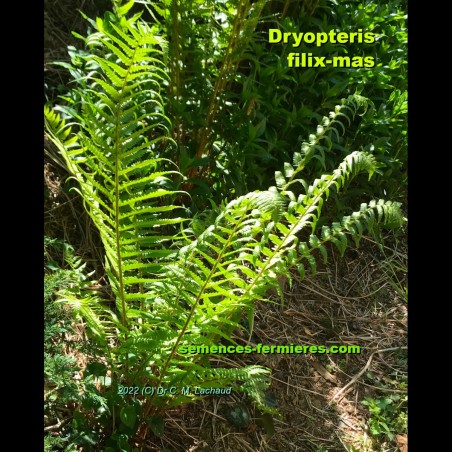






Dryopteris filix-mas - Male Fern
1 stump bare root
-
The Male Fern is a majestic fern that grows in cool, humid areas and in the woods
However, it is also capable of withstanding full sun and resisting extreme conditions of temporary heat and drought
This robustness makes it an interesting fern for the garden since it does not have the fragility of most ferns
The Male Fern belongs to a family of terrestrial plants (Dryopteridaceae) which appeared more than 100 million years ago, and which includes about ten genera, including Dryopteris (approximately 400 species)
Dryopteris filix-mas is endemic in Europe with the exception of Mediterranean regions
In France, it grows up to 2000m altitude
It is no more "male" than its cousin the Female Fern (Athyrium filix-femina) is "female"
Dryopteris filix-mas is a magnificent and vigorous fern used in the ornamental garden to set a high bed even in full sun, as an isolated subject, or grown in pot
Its fronds unfold in spring from a scaly stump firmly anchored to the ground by a network of fibrous roots, and rise to a height of up to 120cm
The Male Fern is extremely hardy since it grows in Scandinavia, but its vegetation is deciduous and dies after the first heavy frost
Dryopteris filix-mas has medicinal properties: Anodyne, Antibacterial, Anti-inflammatory, Anti-rheumatic, Antiviral, Astringent, Febrifuge, Vermifuge, Vulnerary
It can be used for dyeing textiles : Its fronds give pretty, very saturated and solid reddish browns, but only when the spores are mature and before they are dispersed
The dyeing principle is therefore probably in the spores rather than in the leaf tissues
-
| Jan | Feb | Mar | Apr | May | Jun | Jul | Aug | Sep | Oct | Nov | Dec | ||
|---|---|---|---|---|---|---|---|---|---|---|---|---|---|
| Z3 | |||||||||||||
| etc. | |||||||||||||
Find the best location for your Dryopteris filix-mas
Any type of soil is suitable, but your Dryopteris will grow wonderfully in fresh soil rich in organic matter (in our garden, some specimens grow perfectly on shale scree)
Plant the rhizomatous stump as soon as you receive it, ideally during the fall and winter, burying the roots and the lower half of the stump (and leaving the upper half protruding) in clean, decompacted soil
Water and keep the soil moist
The fronds emerge in spring, and if they are cut during the growing season, new fronds will replace them
In winter, the leaves dry and die and the fern goes into vegetative rest
Cut the dead fronds at the stump level and drop them around the stump where they will decay and provide organic matter, while saving you weeding work next spring
No other maintenance apart from regular watering during the planting year, and particularly in dry periods
No disease, no pests
Easy cultivation
You might also like
Payment :
PayPal < 150 €
Check < 850 €
Bank Wire > 149 €
Thank you for your kind understanding